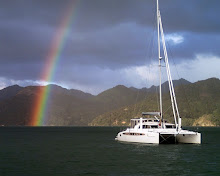

After a hot, hot night in Bahia Concepcion’s El Burro Cove, we continued south down the east coast of the Baja peninsula to a small bay, just north of popular San Juanico, called La Ramada. We motor-sailed the entire way into winds from the south-southeast. Sailors speak of winds relative to the direction from which they blow such as northerlies, southerlies etc. Another cruiser here in Mexico this season referred to the winds he usually encountered as “noserlies”, meaning that no matter which direction he intended to sail, the winds seemed to frequently be on his nose making progress under sails alone rather slow and challenging. With northerly winds forecast, we had hoped for a good day of sailing but were greeted with “noserlies” instead.
La Ramada turned out to be another beautiful spot with good protection from southerly winds, a long sandy beach and trails connecting the cove to nearby Bahia San Juanico. We shared the anchorage with three to four other boats, met new friends and reacquainted ourselves with others that we had met earlier in the season. We spent several days hiking, swimming and snorkeling there. Peggy, a friend of ours from the vessel “Interlude” snorkeled with Anne one day and showed her how to catch tasty “chocolates”, or chocolate clams, by looking for their siphon holes in the sandy bottom and diving down to scoop them out by hand. They are named thankfully, not for their taste but for the color of their shells. She returned to “Blue Rodeo” with about 20 in her mesh bag and left them hanging in the water overnight to expel the sand that is often found inside their stomachs. By the next morning, soft hearted Anne was feeling a bit guilty for taking the creatures so she set them free to do whatever clams do. Soft hearted as she may be, it’s doubtful that she would do the same if she ever catches a good-eating fish like a dorado or a tuna. With an unsatisfied craving for fresh sea food, we took our new spear gun and traveled by dinghy about a mile up the coast where Mark dove into the water with snorkeling gear and managed to get a decent-sized fish with his first shot. That turned out to be the easy part as filleting it on our transom swim step proved more difficult and messy. Mark’s opinion of the hassle involved seemed to evaporated that evening when Anne prepared delicious, fresh fish tacos with spicy mango salsa. Yum, yum, yum.
Soon it was time to continue south once again and we enjoyed a pleasant day of sailing with light but favorable winds to Isla Coronados, a beautiful volcanic island that we passed on our way north. While there, we joined Cindy from the vessel “Bravo” for a hike to the top of the island’s cinder cone. The trek proved to be strenuous due the steep jumble of rocks that had to be traversed and the searing heat. As we ascended, the views of our boats anchored in the beautiful bay and the surrounding mountains and sea made the climb worthwhile.
From Isla Coronados, it was on to Isla Carmen where we anchored by ourselves between the dramatic cliffs of El Refugio on the island’s north side. We snorkeled there and explored the many sea caves alone the rocky shore. Later that evening, we found the sounds made by air escaping from caves as the ocean swells passed by to resemble that of playful, spouting whales.
Wanting to see more of the island’s special areas, we motored first to the west side where we spent a night in scenic Bahia Ballandra then reversed course the next morning and sailed around to the east side to Balia Salinas. We anchored there off an abandoned salt refinery and “ghost town-like” village. A trip to shore and a waking tour of the remaining structures was quite a treat as our imaginations took us back to the days when the small town housed many families and featured, a school, church and several stores. The large salt pond nearby remains but apparently, the economics of the operation no longer made sense. The high point of our overnight stay was the opportunity to snorkel on the wreck of a 120 foot tuna boat in the center of the bay. We made two dives on the wreck marveling at the quantity and diversity of fish that make the wreck their home. We were, at times, completely surrounded by hugh schools of fish of all sizes, shapes and colors.
From Isla Carmen, we had a pleasant three hour sail to Puerto Escondido, a nearly land-locked bay, eleven miles south of Loreto, with a small marina and a large number of moorings. We dropped our sails, motored into the bay and secured “Blue Rodeo” to one of the moorings for two nights. This gave us the opportunity to use the marina’s internet access, do some minor re-provisioning at a small market down the road and do two loads of laundry. When we leave here today, we will, once again be traveling through fairly remote areas and won’t have much contact with the outside world until we reach La Paz on July 15th. We look forward to stopping at a number of coves and islands along the way that we enjoyed last month. The days and nights continue to get hotter, and sleep is difficult at night, but we can’t complain too much as this means the water temperature continues to rise and we are able to swim and snorkel for hours without getting chilled.















